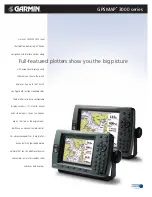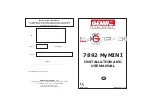
96
Basic Operation
Procedures
Selecting an LPV Approach
For this example, we’ll use a flight from Eugene Oregon (KEUG) to Salem Oregon (KSLE) and select the RNAV
runway 31 approach. “GLORR” intersection is selected as the IAF. Of course, vectors-to-final could also be
selected, as previously described for the non-precision approach examples.
1. With Salem (KSLE) as your destination in your flight plan, press the
PROC
key and select the “RNAV
(GPS) 31” approach.
2. From the transitions field, select “GLORR” as the IAF. Review and execute the modified flight plan. Go
direct to GLORR when cleared “Direct GLORR” for the approach.
Flying the LPV Approach
1. Within 30 nautical miles of KSLE, the GNS 480 switches from en route mode to terminal mode and the
CDI scale transitions from 2.0 to 1.0 nautical miles, full scale deflection.
2. As you approach the IAF (GLORR), a waypoint message (“LEFT TO TRK 312°”) appears on the bottom
of the screen.
3. As the distance (DIST) to the IAF approaches zero, the message is replaced by a turn advisory that
counts down 10 seconds prior to the turn.
4. As you approach the FAF (LOTKE), the GNS 480 will begin to automatically rescale in an angular
fashion. This will allow the LPV approach to be flown in the same fashion as a standard localizer
approach similar to an ILS. This is true for both the lateral and glidepath guidance. At 2.0 nautical miles
from the FAF, CDI scaling is tightened from either 2° or 1.0 to 0.3 nautical miles, full scale deflection,
whichever is smaller.
5. Sixty seconds prior to reaching the FAF (LOTKE), the GNS 480 will check the required Horizontal
Alarm Limit (HAL) and Vertical Alarm Limit (VAL) to ensure the GPS position integrity is within limits to
complete the LPV precision approach. In the event the HAL or VAL limits are exceeded, the approach
will be downgraded to a non-precision approach, when available, indicated by “Lnav” on the moving
map, otherwise the approach will be aborted. A message will note that the approach is downgraded
and the glideslope indicator will be flagged. You may continue the approach using LNAV non-precision
minimums if there are LNAV minimums for this approach. In the rare event the GPS HAL or VAL limits
cannot meet non-precision limits, the GNS 480 will notify the pilot with a message to abort the
approach. The GNS 480 will revert to terminal limits to support navigation to the missed approach.
Содержание Apollo CNX80
Страница 1: ...DRAFT GNS 480TM color GPS WAAS NAV COM pilot s guide...
Страница 16: ...8 Getting Started...
Страница 17: ...9 Getting Started...
Страница 18: ...10 Getting Started...
Страница 24: ...16 Getting Started Nav Terms Diagram Flight Plan Terms Diagram...
Страница 160: ...This page intentionally left blank...
Страница 161: ......















































